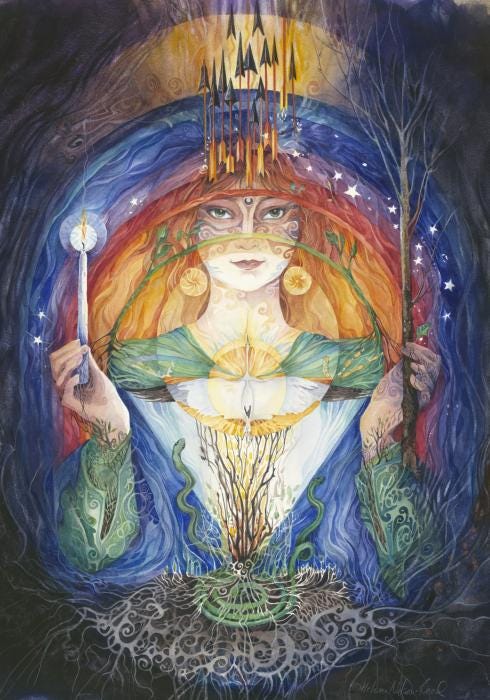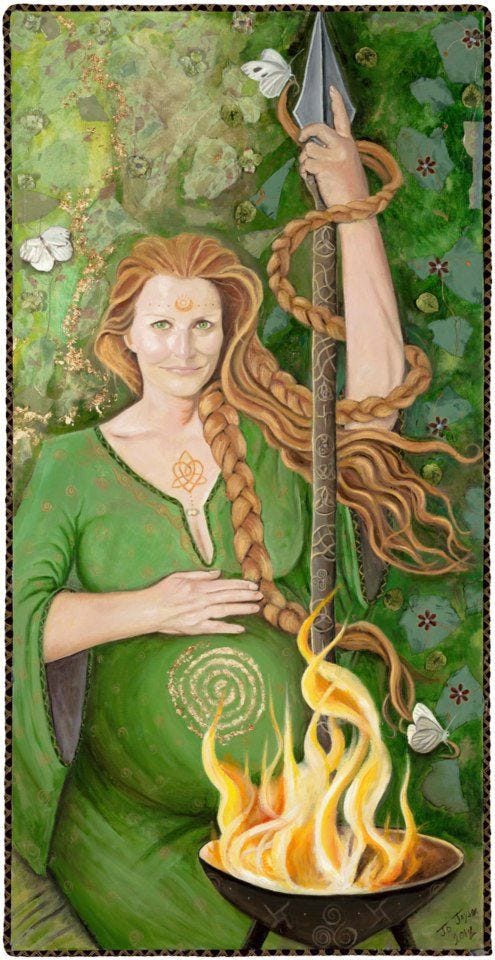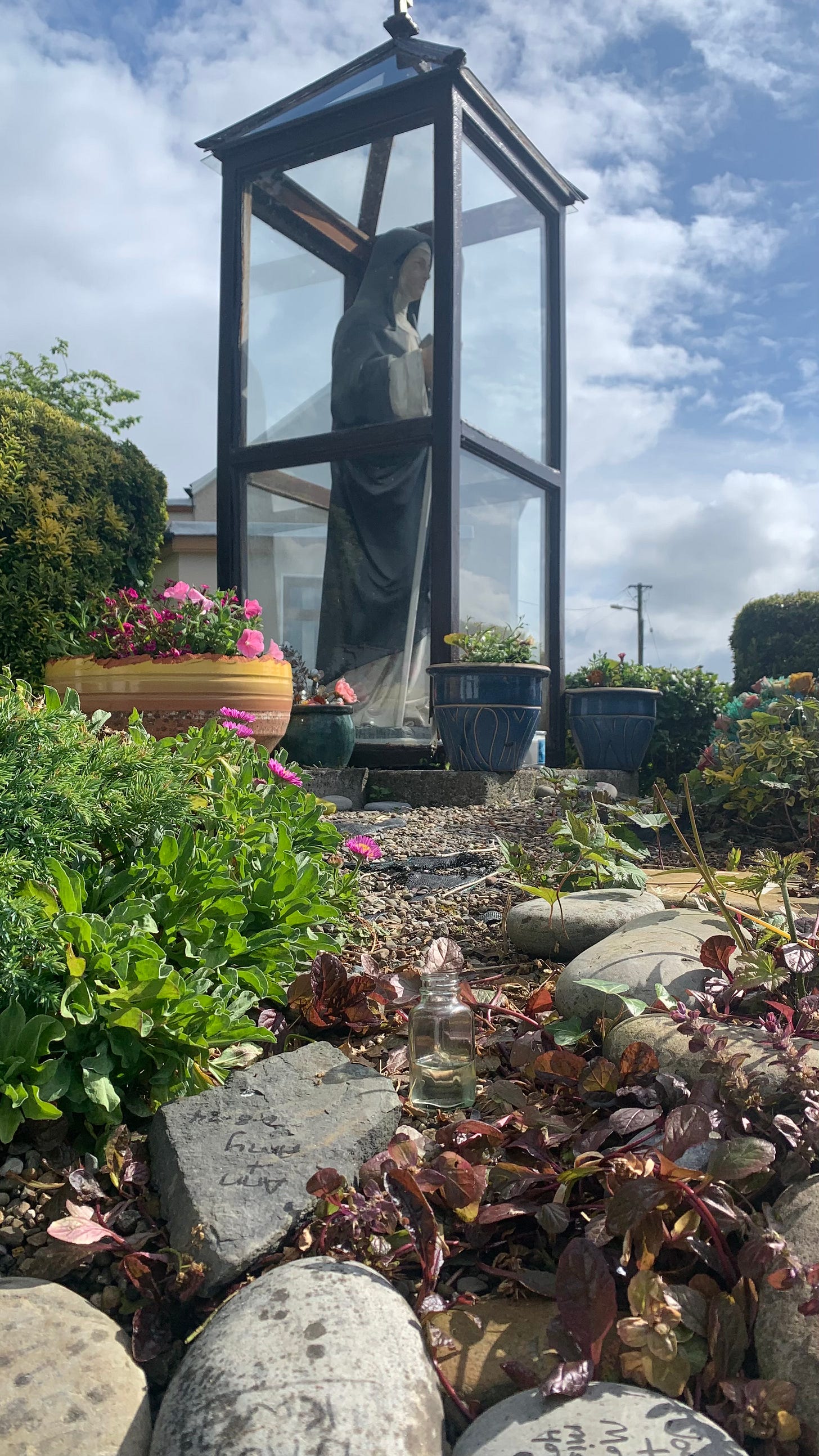Brigid
The Goddess Brigid is beloved in Ireland, known by many names through many stories, myths, and legends.
I became most familiar with Brigid through my work with Ancient Celtic Tree Magic, as her medicine is intertwined with that of many of the trees. (She’s usually present in our discussions of Rowan, Willow, Oak, and Hazel.)


She is most commonly known as the Goddess of the healer, smith, and poet. Over time she’s been associated with myriad aspects of life including: wisdom, poetry, healing, protection, smithing, craftsmen, domesticated animals, agriculture and cattle, childbirth, mothers and children, hearths, spring and new life, dawn, wells and rivers, music and art, and fertility as well as higher ground, higher learning, and higher consciousness. She’s a triple Goddess (sometimes three sisters all named Brigid) and a Goddess of both fire and water.
In lore, she is one of the Tuatha Dé Danann, the daughter of the Dagda (the good God, generous, fatherly, earthly, giver and taker of life), the wife of Bres, and mother of a son Ruadán whom she could not protect. She is said to have been born with a flame atop her head connecting her to the source of life. She is often pictured with bright red hair and a flame coming from her head.
The Goddess Brigid was so beloved in pre-Christian Celtic culture, she was brought into Christianity so the adoration could continue. St. Brigid (5th century CE) is associated with the same facets of life as the Goddess Brigid before her. The name Brigid means ‘Exalted One’ and very well could have been a title rather than a name for the human woman who would become immortalized St. Brigid.
It seems to me that the Goddess Brigid, the Exalted One, could simply have been the Goddess in all her glory: the feminine aspect of the divine and creation.
In her book Brigid, Courtney Weber writes: “Brig, the Exalted One, was said to be so great that a human could only reach as high as her brass shoe. While Brig was spirit of many things, she was primarily the green earth itself. This should not be confused with being a Goddess “of” the earth. Brig was not a caretaker or steward. The earth was alive and cognizant. Brig was its spirit and the soil, rocks, hills, and rivers were her body.”
There’s more lore than I could hope to know or recount, so I’ll stay focused on what was evident to me as I connected with her and collected an essence at her well in Liscannor in County Clare.
The Story of Collection
Finding Brigid
It shouldn’t surprise me that I was led to Brigid’s well, because in the days before, I prayed for direction, inspiration, and knowing. I was feeling a bit lost, and I deeply desired to feel grounded, clear, inspired, connected, aligned. Even one of those would have helped. Mostly I felt I needed direction, and I knew the first step towards that was to get grounded, which would help lead me to clarity.
There were lots of touristy things I could have done in county Clare, but I had trouble making a choice in my disorganized mental state. After some back and forth, I chose to visit St. Brigid’s well, which popped up on my google map, letting me know it was nearby. I found my way after getting a bit lost and finally stopping to ask for directions. When I arrived, I was pleased to be the only one there.
As I approached the well, the site’s power stopped me in my tracks. I paused before entering the gate, relieved. I took a few moments to breathe, feel and listen. I entered and slowly made my way to walk clockwise around the circular stone platform that held the statue of St. Brigid in its center, taking it all in.
I was curious to find out what had led me here, how it related to my Ireland pilgrimage, and what medicine beloved Brigid desired to share. My method for receiving such information, as you may know by now if you’ve been reading these transmissions, is to allow my clairsentience (intuitive sensing/feeling) and claircognizance (intuitive knowing) tune me in to the wisdom frequencies that are present. Allowing my self to just be is usually what makes it easiest to receive these transmissions with clarity and ease.

Sacred Sites and the Power of Prayer
The first concept that occurred to me as I walked around the statue was the power of prayer. The palpable energy I felt at this site was the presence of thousands of prayers. I felt the energy of so many heartfelt, deeply rooted requests for help, and Brigid’s response of love and support. The word supplication kept coming into my mind, and I made a note to look it up to make sure I understood precisely what it meant.
The words always included in its definition are humble, earnest, prayer, plea, request. That was indeed what I was feeling: the earnest requests for support. The strength of this energy at the site is due to its concentration in one location, the wide range of topics for which support has been requested, and the incredible length of time during which people have been asking Brigid in some form (whether the pre-Christian Celtic Goddess or the Saint Brigid) for her protection, help, and favor. All of these factors contribute to the assembly of energies I felt as I took in the energy of Brigid at her well.
It occurred to me then that there may be several reasons a site will be considered sacred. Sometimes it has to do with the location of the site: ley lines converge and create a potent spark of energy; something important happened there; or a both of those. And sometimes a sacred place is made sacred by our actions — for example, thousands of prayers over many years linking in connection with a Goddess who has received thousands more prayers over hundreds of years (at least).
This place has become sacred, as far as I can tell, because the well is associated with Brigid, and as a result, people have been bringing their earnest, heartfelt prayers and requests there ever since. Whatever may have happened before, the sheer energy of all that prayer has made this a potent sacred site.





